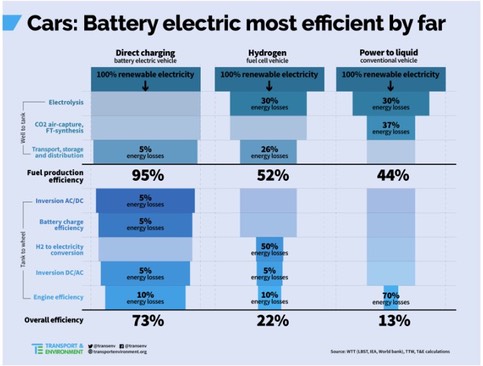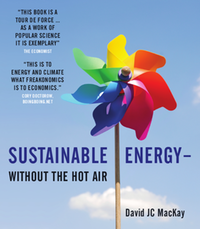To estimate efficiencies I will use in the following consumption data as recorded in driving cycle tests.†
Tesla Motors specified for their Roadster a range of 340 km according to the “European Electric Vehicle Combined Cycle” - Test, or 390 km according to the EPA 2-cycle test. The battery holds about 53 kWh. In practice this 340 km range can be easily driven, even across Alpine passes. This yields an average EPA-cycle consumption of 140 Wh/km (14 kWh/100km). Its drivetrain is exceptionally efficient and most prototypes and “Fleet Test Models” have so far been unable to match this performance. More detail on these range data I assembled here and some references to external reports can be found via my Links Page.†

Let us assume for this efficiency comparison that a petrol powered sports car consumes for the same cycle 10l/100 km, about 23.5 mpg US. Most equally quick cars would consume much more than that. Petrol stores 9.4 kWh/l of thermal energy, so the conventional car consumes 94 kWh/100km, about 7 times more Energy than this roadster. The more local, slow start and stop traffic is included, the larger the advantage of electric traction becomes. Even if the losses in electricity generation, distribution and charging are accounted for, electric traction has a considerable advantage left. We should also not forget that petrol is produced in a refinery with significant energetic input and has to travel a long way to the final user. For more detailed “Well to Wheel” comparisons have also a look at e.g.†publications of the EPA(US). The electric roadster uses about half the energy that some of the most economic cars would use today. If you include then that a lot of electricity is already, or at least can be generated very cleanly, the resulting reduction of pollution and CO2 production becomes very large. Even if you just use coal to generate electricity, the Tesla Roadster will emit less CO2 per km driven than comparably quick petrol fueled cars. It may be also worth a thought that there is a notable difference whether exhaust gases are blown directly into the city dwellers faces or whether they escape from a high rise flue hundreds of kilometers away.
Incidentally this calculation tells us also why comparisons with “energy in the tank” do not tell very much. An “electric tankful”, the charged battery, does not need to hold an amount of energy comparable to the thermal equivalent of petrol in the tank. Misleading is also the use of theoretical efficiencies of conventional piston engines. These efficiencies are never achieved under actual driving conditions. I have added additional calculations and observations on the effects of this high efficiency on a page titled “More on Energy Efficiency” and more on range data I assembled on the driving range page.
It is surprising that the discussion surrounding the use of Hydrogen as a fuel is rarely touching the question of efficiency. Poor efficiency from “well to wheel" invariably inflates costs, as also highlighted by Herbert†Diess of Volksawagen (2019†in German). Here is an overview and comparison with the direct use of electricity as collected by Bossel (IEEE Proc. 2006):
Or also here:

Energy efficiency is not the only issue related to technological change in products used and produced worldwide in large volumes. Perhaps the most frequently heard objections are suspected problems related to Lithium batteries. Lithium supply is fortunately not an issue for the foreseeable future. 500‘000 cars with 24 kWh-batteries would require less than 10% of todays Lithium production operating currently at about 75% of its capacity. Sizable expansions of Lithium production are planned and possible. Lithium is also absolutely not a rare element, Lithium batteries can be recycled and the waste is not toxic. Current lead-acid batteries are horribly poisonous in comparison. Studies covering the whole cycle, from mineral to production and the running of an electric car with Li-Ion batteries, have confirmed that the electric car keeps its advantage over cars with combustion engines. Another suspected problem sporadically raised is the limitation of some rare earth minerals supplies. The authors seem to be unaware that not all electric motors need equal amounts of those rare earths and that not all of those elements are also rare, inspite of their name. In general such “full cycle”-studies have to be taken with a grain of salt. Many estimates have to be made and many significant uncertainties remain and are too often not addressed or highlighted.

